You’ve got your brand new Log Cabin. It’s up and it’s chucking it down, it’s January with record rainfall, floods everywhere and your poor log cabin is bare wood, soaked… You need treatment don’t you? – PANIC!
No need to panic! Wait a little while, relax, stop worrying about her, she’ll be fine for years – sort of!
Don’t Panic!
This Log Cabin belongs to a friend of mine I supplied from Tuindeco years ago. Apparently, after 12 years she’s still deciding on the right colour…
Look at the state of the poor old thing! Very neglected and unloved it would seem but it’s home to chickens on the veranda and guinea pigs inside during the winter. Very much loved and used, so she tells me.
I do despair, just look at it! But the point of this is that it is not rotting and it’s still a very solid untreated log cabin.
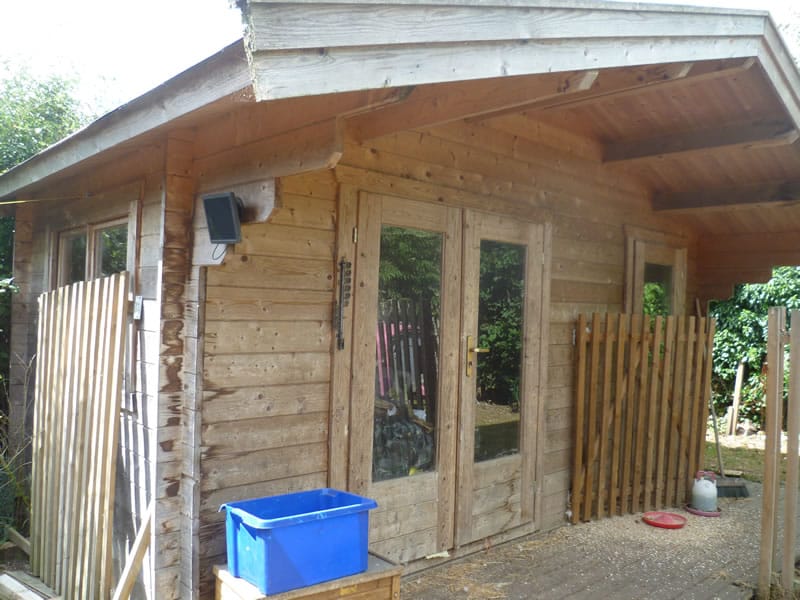
A log cabin that has never been treated in it’s twelve year life span.
I’ve asked her to keep leaving the choice of colour until later just so I can see what happens. I hope to post again in ten years when it’s still standing.
Yes the poor ol’ thing has her problems. You can see in this picture how dry the timber is, it’s cracking and shrinking. These pictures were taken last summer so she will look different now. See a post on cracking and splitting in timber for a little more insight into what is going on with timber cracks.
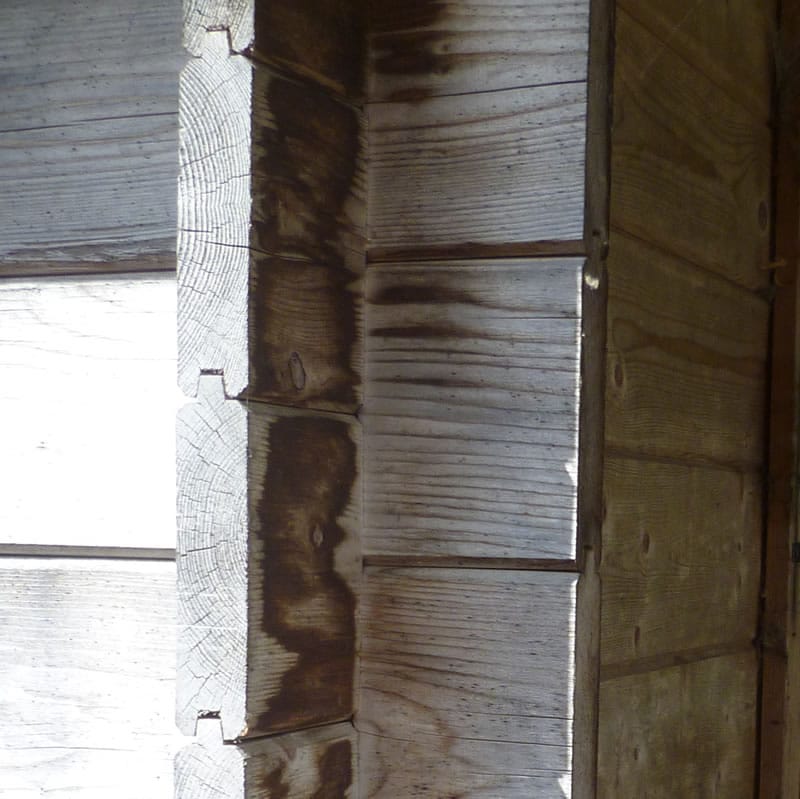
Cracking and splitting of log cabin logs
She’s got one or two more problems as well. Nothing insurmountable though, for instance, this log cabin has a few friends:
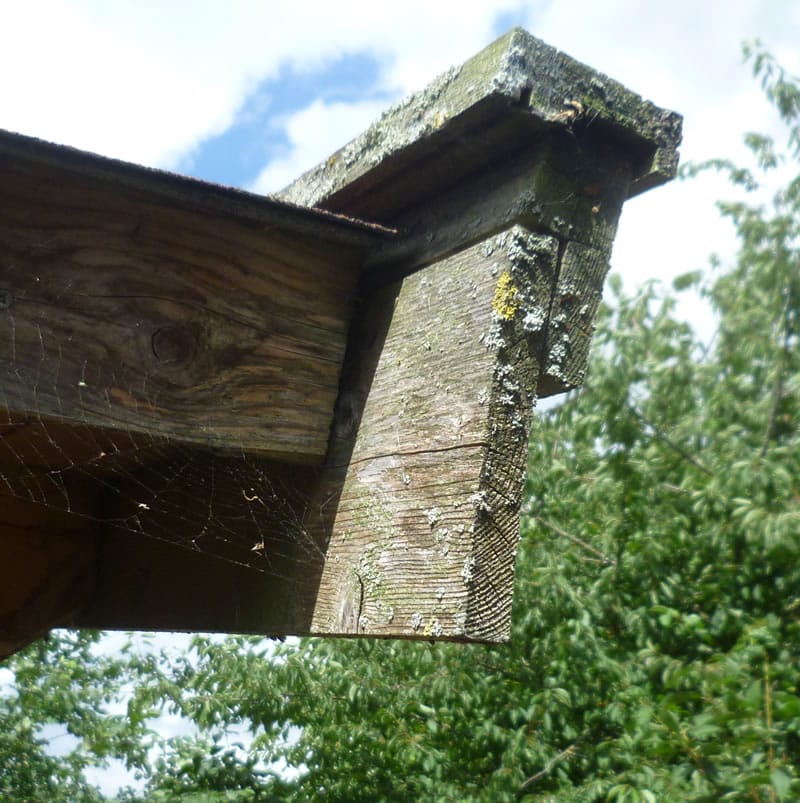
This log cabin is suffering with mould and fungus.
Yup, it does have a little fungus on it. It’s not dry rot as it is way below a moisture content of 20%. It’s also never at a steady temperature of 23 degrees. Both conditions need to exist for dry rot to occur. It’s just good friends and they like each other, no harm done.
Here’s another friend:
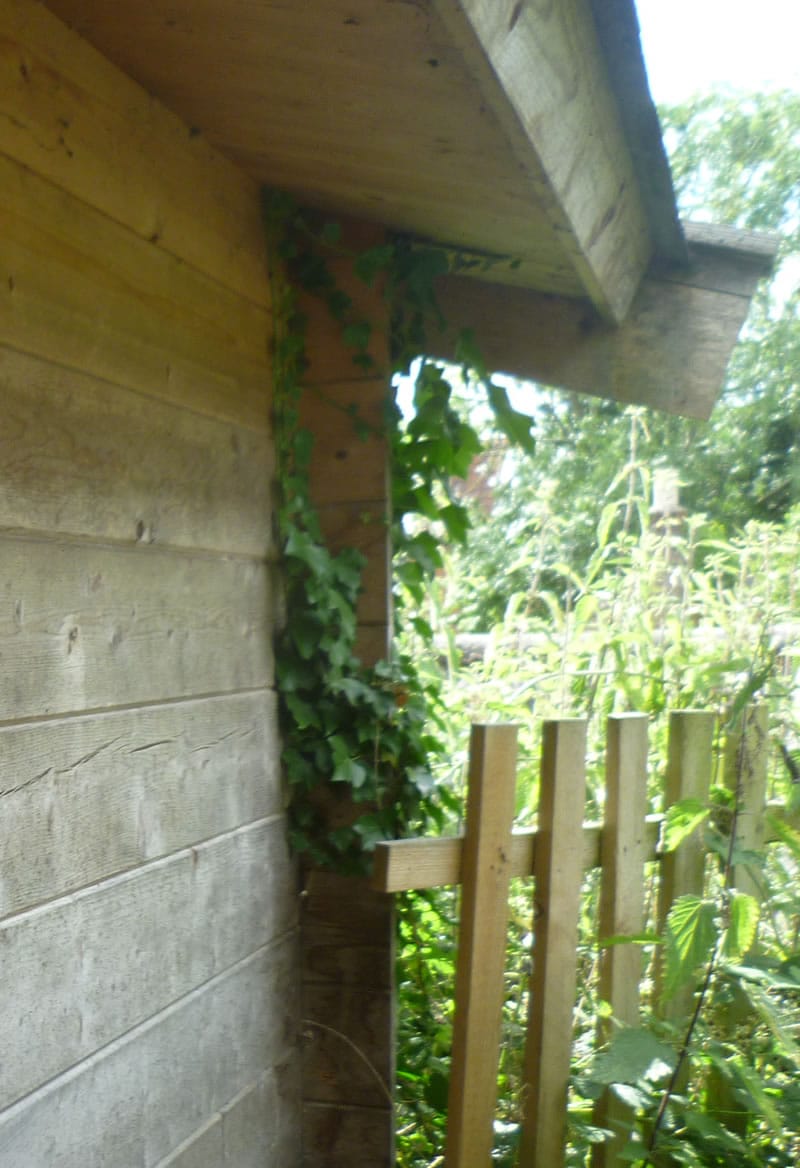
Another friend attaching itself to an old log cabin
The back wall of this log cabin is covered by a hedge. It’s never been cut and now Ivy is growing over it. Despite the outcome, the old girl is still going strong and fully in-contact with a hedge and all sorts of undergrowth.
Overall though she’s jolly good. For a log cabin of this age, no treatment ever, she’s still solid and displays no rot at all. Here’s the doors and Roof Purlins:
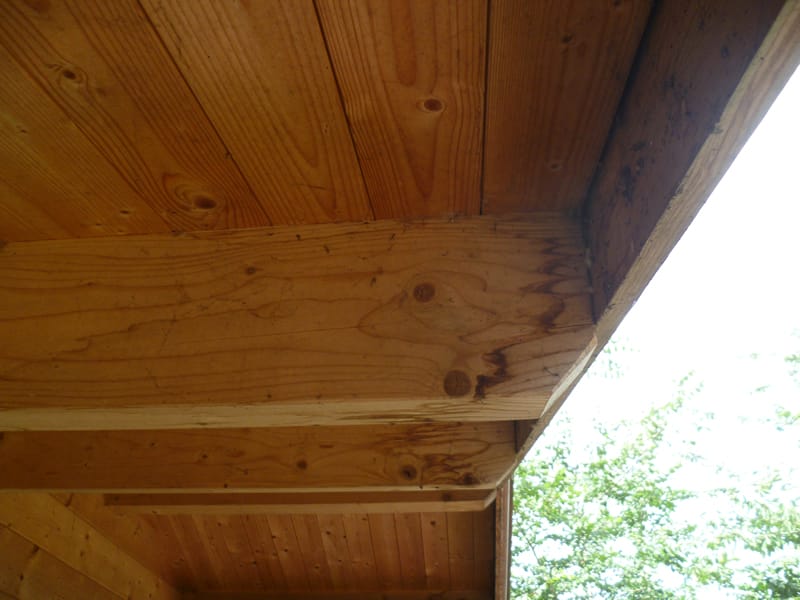
Untreated purlins on a very old log cabin
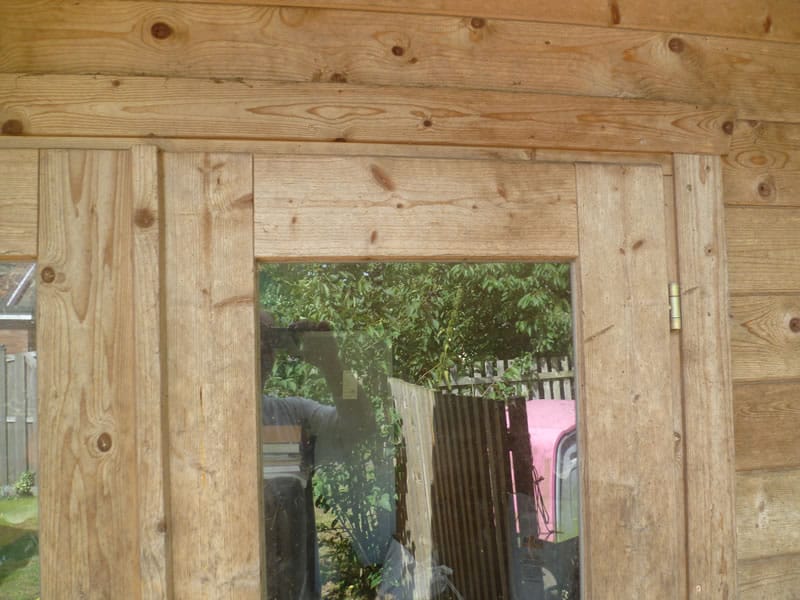
Untreated doors on a log cabin, they have warped a bit as have the windows which don’t open but not too bad.
We give a ten year guarantee on our logs cabins against rot. Conditions and regular treatment, blah, blah, blah… If it was up to me, I’d give a twenty year one and no treatment. It’s impossible for timber to rot!
(Ok, maybe that’s a bit optimistic. It’s impossible for timber to rot providing it is always VENTILATED and allowed to DRY.)
So I reckon our guarantee is safe. It won’t happen though if she’s allowed to breathe, and, that’s the key with all timber products – ventilation! If it gets wet and it’s allowed to dry out it will NEVER ROT and that’s an inherent property of timber. Not just ours but any timber, providing it is timber of a suitable quality for its intended use. Especially for log cabins watch out for where the timber comes from. Slow gown, cold climate etc.
Walter Segal
Just a quick note, I’m a fan of this chap. He’s done a lot for home building and one of his principles was that of timber ventilation with buildings on stilts. Ventilated timber does not tend to rot. It’s why I love timber frames as bases for log cabins and I’ve been involved with lots of log cabins on stilts and similar construction methods they all work and never have I had a customer complain of rot.
Log Cabin And Timber Treatment
Of course with all my above wittering and pictures I am not AT ALL advocating not treating your log cabin or any garden timber. It needs it! And you must treat it at some point, the sooner the better. We’re not actually treating it just to prevent rot we’re treating it for lots of other things.
All I’m saying is don’t worry or panic over it, you do have time to do it without worrying if you can’t do it straight way.
If you don’t treat your log cabin or timber you can have a few problems and rot is not one of them
- Discolouration of the timber. See the pictures above, she doesn’t look that great.
- Warping and shrinkage of timber. The timber dries out, warps, distorts and allows the ingress of water either through seams, pushing it out of shape. Doors and windows may well warp and splits may well appear.
- Expansion, the bloomin’ thing wants to reach an equilibrium with it’s surroundings, it wants the same moisture content that is in the atmosphere. So when it’s moist it wants to be moist as well. We can’t have that! The thing is up and down like a yoyo if we let it. View each piece of timber as a sponge, absorbing and expelling water. We need to to stop behaving like a sponge really. See this article for more on Moisture Content
- As well as the above external pictures, internally, water marks show incidentally, which is unsightly and develops damp spores, especially if internally it is not ventilated. Pay attention to this if you are installing a hot tub. The Log Cabin pictured above ventilates always for the guinea pigs sake. Even though she is not treated she’s still going strong and NOT rotting. This log cabin has a constant flow of fresh air. See this article for advise on Ventilation
- This log cabin is fortunate but insects can attack timber and a good treatment will stop this.
- Attack by UV light causing drying and further splitting. This log cabin is relatively shaded from it with hedges and trees all around, yours may not be.
- Filthy!, inside and out and this is not something we really want with our very expensive log cabin.
- Weather ingress. Even though it may not rot it will still soak up water and this will percolate through to the inside especially at the corners, doors and windows in an exposed environment.
So, What If It Is Weeks Before You Treat Your Log Cabin?
You can’t treat it straight away? What’s the worst that can happen?
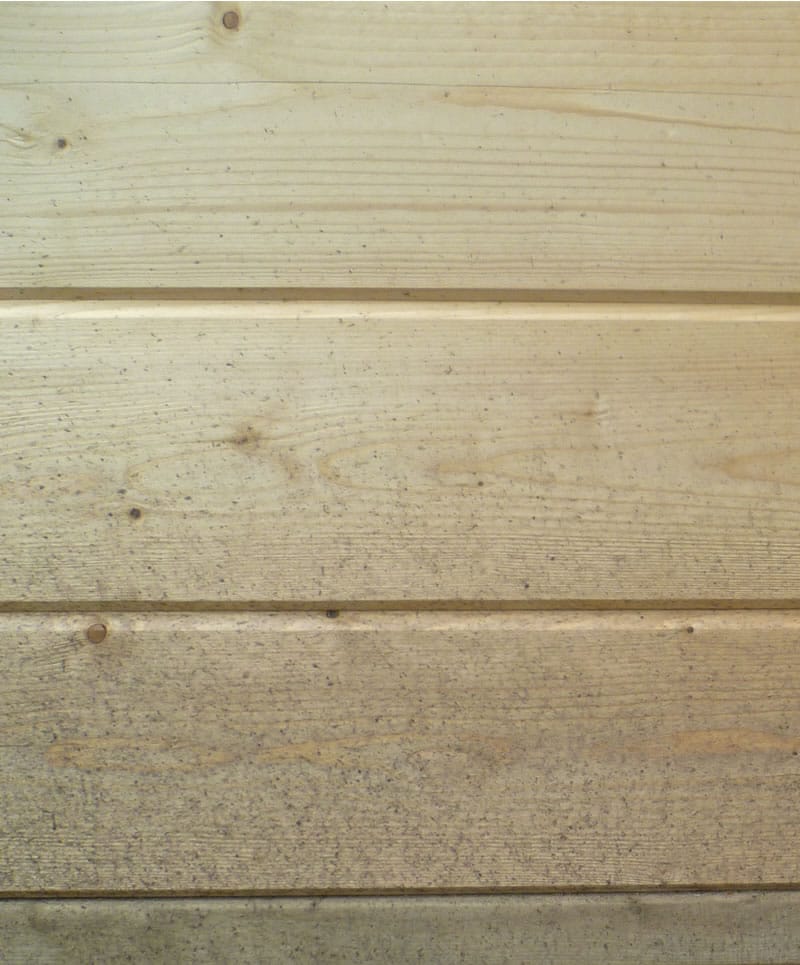
Dirty wall logs on the log cabin
Yup, the poor log cabin gets filthy with rain muck thrown up all over it. When, and if this happens all you need to do is use a pressure washer or a good jet attached to a hose pipe, it comes up like new – honest.
Also, if you find darker marks on it, which are a damp fungus forming, you just need to apply a dilute bleach solution and it will bring the timber back to normal. This will often happen if you’ve left a cabin out in the rain and covered it with plastic while waiting to install it for a month or two. The humidity created is great for a fungus, but easily removable with a bleach spray and then a wash. Our Sauna display cabin had this after being stacked outside for months. A quick spray and a wash and it’s all gone.
Pressure Washer
I’ve installed log cabins in tempest, storms, gales, snow,hail, in fact every weather condition imaginable. You can’t help to get it dirty inside and out sometimes especially big installs. Just before you hand over to a customer (or yourself), give it a good jet wash or hose down, it’s like new regardless of how messy you’ve made it during the installation.
Water Ingress
Timber won’t rot if untreated, but soaks up water by way of moisture transference. This is regardless whether it has been tanalised or not. Even a tanalised log cabin still needs full weatherproof treatment, otherwise it will still behave in the same way.
Stop Ingress And Absorption By Transference We Must Treat It
Did you know on average an untreated wall log which can move by up to 3mm over the course of the year due to moisture transfer.
If You Don’t Treat It At All
If we don’t treat it as well as it getting dirty (least of our problems) we can also have other problems as the logs, doors and windows will expand and contract due to moisture transfer happening too rapidly causing the timber to expanding and contract too quickly. It may also cause warps in doors and windows and splits. This article explains this a lot more – Moisture Content in Log Cabins and Wood.
Purpose Of A Log Cabin Timber Treatment
I’ve said what happens if we don’t treat a log cabin and that it really is a good idea. So now we commit, what do we look for in a treatment?
- UV protection – we need to protect it from the sun, and the sun and it’s light is a bugger, it’ll dry out timber, cause cracking, distortion and lots more, it’s a real bugger for wood.
- Weather proofing. Wood loves water, it soaks it up, it wants it, it’s a property but we’re meanies and need to keep it at steady 14%. We try to protect it from absorbing water. We try to protect the joints and stopping any water marks from coming through. This is also very important for the doors and windows. If we allow it to soak in water above 20% it will start to rot.
- Reaching an Equilibrium … the bloomin’ thing keeps trying, see this post: Cracking and Splitting in timber. We really don’t want this with our log cabin. Stopping this will save us a lot of time and will make it last for years. Stop the equilibrium I say! Moisture Content in Wood
- Creature proofing … Pesky creatures, fungi, worms,etc. A good treatment will stop the pesky critters.
- Elasticity – As I’ve said the thing is moving a lot, even with a good treatment stopping the absorption and shedding of moisture, we need a treatment that can cope with this so high elasticity in also important.
What Timber Treatment Should We Use For Our Log Cabin?
Hm, now this bit can be a hotbed of law suits. Firstly anything expensive, we only recommend Sikkens, Kingfisher, Sadolins or our own European brands shown in our website or brochure such as Koopmans, Embadeco or Embalan. More recently, we have the super treatment from Valvoline Max-Release Protectant – now known as ‘Carefree Protectant’, heralded as a revolution in timber treatment and, from what I’ve seen the stuff is amazing.
We don’t recommend a cheap treatment, especially those designed for Sheds or Garden Fences or which spray on.
Any complaints we have had with cracking timber or mould algae, excessive shrinkage etc have always been found to be caused by a cheap treatment, use at your peril but we will not offer any guarantee if you have used it, I can always tell as well!
Please do NOT use a cheap treatment! The problems reported with a log cabin often trace back to this.
Expensive is the way forward, you get what you pay for and it’s certainly pertinent when regards to treatment. If you use treatment beginning with the third letter of the alphabet and only given it two coats and then complain in a few months time that you have splits I will tell you to apply five more coats of the same treatment or treat it again with something expensive.
If I was to get technical we need a depth of treatment of between 80 and 120 microns. This is the equivalent to two to three coats of an expensive treatment. To accomplish the same depth with a cheap one may take up to 10 coats and this is where the problem comes when customers use a cheaper treatment and give it two coats, you may as well not bother. It’s good on a shed perhaps but no good at all on a log cabin as we need to inhibit its movement. Anything less than 80 microns is not going to do anything.
When asking a treatment supplier always specify it’s for “Planned, smooth Spruce” and let them advise you on the best treatment for that style of timber. Rough sawn treatment is not all compatible.
A great source of advice is Brewers, they’re a professional trade paint supplier and may have other ideas and I’ll always agree with them, they are the people who know treatments! Most of the time they will recommend two undercoats of preservative with two top coats of Sikkens.
My old log cabin was painted 15 years ago with Sikkens, all I do is give it a quick wash each year and that’s it, I recommend it.
But, we have this new stuff: CareFree Protectant.
It dries in 15 minutes, you can paint on it whilst wet, and still provides UV protection.
I’ve even seen it coat grains of sugar in a glass of water and the sugar didn’t dissolve! Clever stuff and now I’ve used it it is amazing, I even tried painting it on wet timber in the rain and all the water wicked away as I was painting (I’m not going to formally recommend painting in the rain though). Amazing! We’re now using this on everything on the show site including Larch and Hardwood furniture / fencing.
CareFree Protectant: The New Name For Max Release Protectant:
With our changing weather conditions our wood / concrete gets a lot to endure rain , sun, wind and frost . To keep your wood / concrete in optimum condition MaxRelease has developed the best protection . The water-borne coatings without organic solvent penetrates into the wood / concrete and thus provides a protective layer against moisture, sunlight , wind and rain for all types of wood and wood products , such as:
- Fences , decking , garden furniture , garden poles , log cabins , gazebos , larch and hardwoods , and concrete products (garden poles and fence systems)
It forms a thin layer on the substrate , so that the structure of the wood and the concrete remains pretty visible.
Benefits of Carefree Protectant:
- Long-term protection against moisture
- Low maintenance
- Easy to apply and easy to clean
- Excellent colour stability with minimal fading due to sunlight
- Less fungal and algae
- Impregnating
- Corrosion resistant
- Water resistant
- Inhibits the natural transfer of moisture
- Prevents kalkuitbloei in concrete
CareFree Wood Protectant is easy to use . Wood Protectant is a quick-drying material and will dry within 15 minutes ( depending on temperature , humidity, type of substrate ) . There is no primer or other type of primer is not necessary in order to bring . To Wood Protectant This makes the long-term protection of wood and concrete in a simple and quick job . MaxRelease Wood Protectant must be stored frost-free.
Having used this extensively now, I really do recommend it!
Damp Conditions
Regardless what log cabin you buy, from us or anyone the Carefree is excellent and one of its properties is protection against humidity.
Now this is clever stuff, it’s water soluble and goes on really well, stopping the formation of damp spores, highly recommended for the inside of a log cabin if shut for months or subjected to a damp atmosphere.
Just quickly note on hot tubs, Log Cabins are great as a hot tub enclosure but make sure you use a vent, this also applies if you are storing lots of damp tools.
Carefree Protectant Timber Treatment
When Do I Treat My Log Cabin?
Now this is something I’m asked all of the time. My stock ‘official’ answer as within the brochure and literature is “Always paint / stain / treat your cabin BEFORE installation”
But, oh my goodness that is a real pain, you get paint in the grooves, on the corners and joints, it’s harder to install. You get sticky patches that then get sticky on your fingers, that then leave finger marks on the inside of the logs. It’s a nightmare!
So you’ve had the official answer, the unofficial and my opinion only is just build the cabin and paint it later. In all the years I’ve been doing this I haven’t had a comeback.
One hint I would give though is when you come to paint it, remove the top of the door and window fascias and paint behind them. Otherwise, once expanded, you’re left with a white line that’ll need painting again. It will never match up so always do it first for ease of mind.
How Much Do I Need?
Another question I’m always asked and this one is tricky. It’s all down to the coverage recommended by your chosen brand. But for instance our stain covers 14 – 15 sq.m and the the paint covers 5-8 sq.m. It does vary on the type and brand of paint or stain your are using. It’s best to work out the log cabins dimensions and calculate it and then give this measurement to your supplier, or do what I do and guess and if you run out get some more.
What About The Roof?
I’ve had customers ask about treating the roof. My answer is always why bother? Proper roof cover application cancels the need for this.
Summary Of Wood Treatment For Log Cabins
So, in summary what have I said:
- Don’t panic over getting treatment on your log cabin if wet or raining when you unpack and install your cabin.
- You have a little while before you need to worry, especially if you have a pressure washer or a jet hose so you can keep in clean
- You do NEED to treat it to make sure it lasts and helps to inhibit the transfer of moisture.
- Clean it with a bleach solution for spores or a jet of water for dirt.
- ALWAYS keep it well ventilated. Ventilation and allowing timber to dry if wet stops all Rot. Here is further information on Ventilation in a log cabin
- ONLY use an expensive treatment so you know that you will be getting a depth of at least 80 microns. The more expensive it is, the deeper it will be and the longer your log cabin will last. More importantly, if you’re lazy like me, you probably will not need to do it again for a good while. Do NOT use the lower end of the market to treat your log cabin I guarantee you will have problems as they do not inhibit the transfer of moisture which is important with log cabins. Please see this article for more on Moisture and inhibiting it in wood.
- Watch out for the natural equilibrium of timber, inhibit this with a good treatment and make sure it is high in elasticity.
- Follow the manufacturer’s advice. If it says three coats give it three coats. It is all about the depth attainable of the final finish.
Depth Of Treatment And Moisture
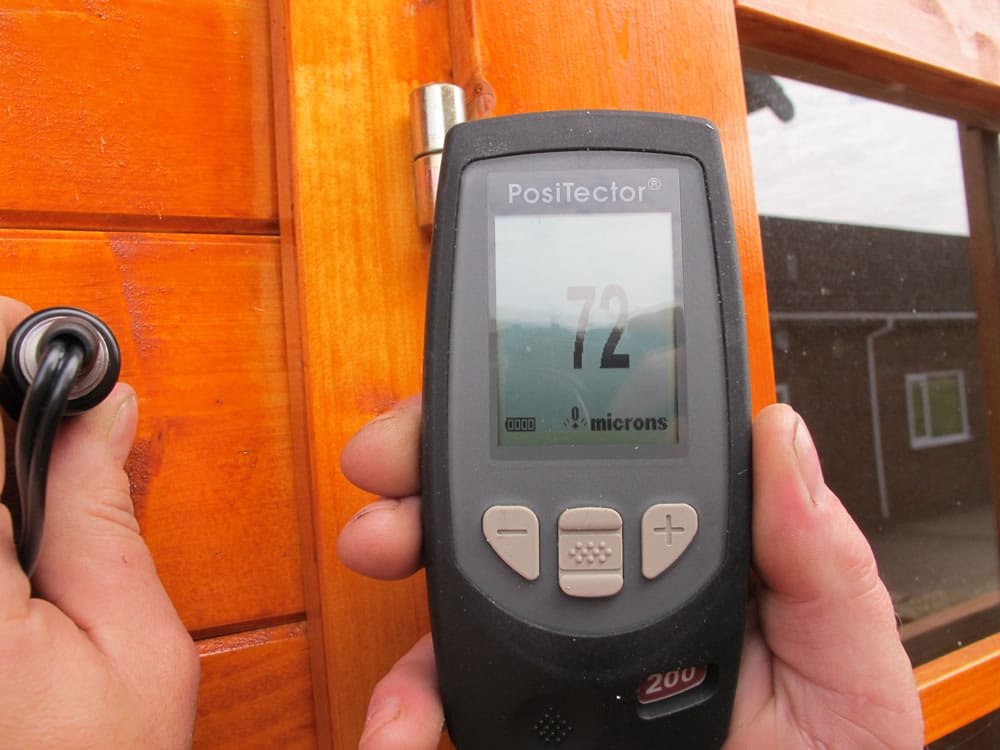
Please see another post on the depth of timber treatment and the correct moisture content for log cabins.
More information on the Depths of Treatment and Moisture content of your Log Cabin
One final note, customers will often leave their cabin install until the ‘weather is better’ or look for a ‘weather window’. In my opinion it is always better to get it up and worry about treatment later. Don’t let a bit of rain put you off!
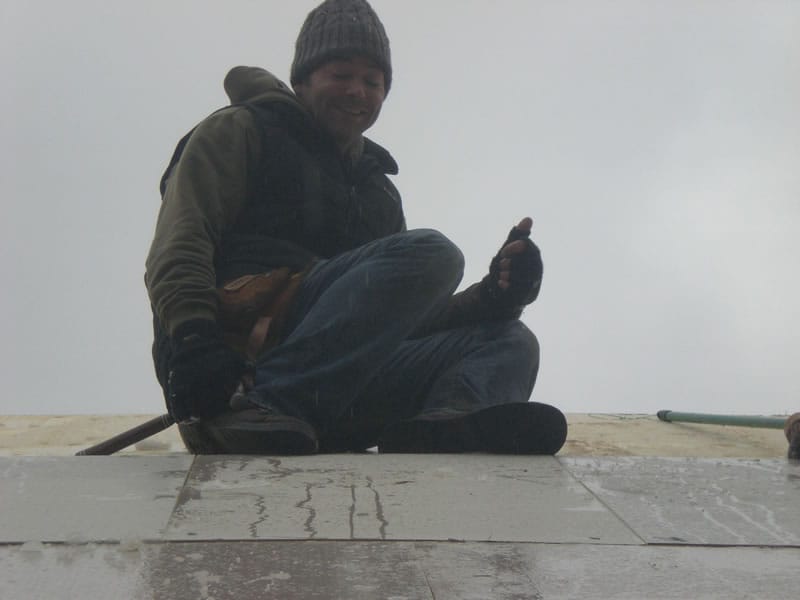
I have written another post on Treatment following a customer’s question that needed a little more advice: Treatment of a log cabin – A Customer’s Question you may find this interesting.
Please also see another post: Log Cabin Treatment Gone Wrong
This post relates entirely to the Tuin range of Log Cabin Treatments and clarifies what and how we recommend they are used if you choose to use our range.






Nice Blog! The information you have provided is incredibly detailed and insightful.
Hello Richard, I had a bespoke cabin assembled three days ago, the cabin has the factory immersion treatment applied ( Honey colour) Have several tins of the Carefree Protector (light oak) to apply to the outside of the cabin when weather clears up.
Cabin is a 58mm wood thickness model, which sits on a wooden frame and supported off the ground by1250 mm long ground screws supplied and fitted by the company Great British Ground Screw Co of Durham.
Floor and roof are both insulated and has a Hayloft Oak laminate floor, also fitted are air vents, with a set of three windows all double glazed.
I would like to keep the inside light and airy with the Honey finish as it is.
My Question is………….could l leave the inside of the cabin without applying any other coats, if not, can you recommend a seal / varnish beginning with the “19th letter of the alphabet” that would allow the honey colour to be kept, or another stain/ varnish which could be applied that would keep the cabin light and airy ?
Keep the good word up Richard, you are needed !!
Hi Pete
Thanks for your message, Sadly Richard has retired so cannot reply directly. I should be able to help non the less. It sounds like a great project you have ongoing there and hope it’s all turning out ok so far
happy to help with your question around treatments, As your building was immersed you’re safe in terms of protecting the actual wood itself. The immersion is a very effective timber protectant. Although what it won’t do is seal off the wood completely which overtime could allow dirt to start showing as it gets embedded.
The S treatments you’re suggesting do offer a nice clear product that could work for you, i have used it myself and it did the job. Although the most common shade is White/off white of course as it can really lighten up the space and make it look even bigger
Hope this helps, Ben
Hi, would you recommend Sandtex 10 Year Exterior Satin Paint at all? Also do I need to prime the wood before painting regardless of the paint I decide to use or are there some paints that don’t necessarily require priming first?
Hi Andy
Im afraid we have never tried that product before, The thing to check will be the stated depth that it will achieve, we talk about this more on our treatment page
As for the need of any primers, you would be best to check the data sheet itself as it varies from one product to another, our carefree for example does not need anything
Hope this Helps, Ben
Hi Richard,
I’m going to build my new Tuin Cabin (custom one based on the Meg) in the next couple of weeks and have been checking out the treatment options. The Carefree Protectant seems to stack up well, expensive but seems worth it. I noticed you refer to it as a fairly new product, how is it in terms of longevity now you’ve used it but also in the show site? Additionally, If I’m correct this just goes straight on the untreated wood with no other products needed?
Hi Keith
Happy to help, the carefree has proved to be a very superb treatment i have to say. Expensive, but effective on our log cabins. Nearly all of our showsite cabins were treated with carefree for around 4 years, We applied a single top up coat at the two year mark and at no point do we have any discolouring or ingress issues on any. I can also confirm straight onto bare wood is correct. No primer needed Prior
Hope this Helps, Ben
Richard, is there an option for the corner log cabins, such a Jannie, to be pre-painted and treated prior to delivery?
There is two options, one is an undercoat spray paint and the other is an immersion treatment.
HI Richard quick question as I’m about to lay my floor it says it is advisable to preserve the under side of my floor before fitting. what do you recommend I use on the under side of the floor ?? I have started using Ronseal wood persevere on the outside of my cabin ( 2 coats before the top 2 coats of stain ) but wondering if I can get away with just using 2 coats of this on the underside of the floor boards or if I need to at all. I have built the cabin on a raised wood den deck I have a DPM under neath it all and have 50mm insulation between the joists am I going over kill here ??
I think you’ve got everything covered well. If the base is good I wouldn’t bother doing under the floorboards, the same as I don’t worry about the roof boards. Treating underneath is a belt and braces approach.
quick one just realised I put Ronseal on here as what I’m using. its not I followed your guidance and went expensive with Sandolin intention is to varnish top side of the floor boards but just worried I need to do the under side
Hi, thanks for the articles, they’re really useful.
I have a log cabin that is about 10 years old and about 6 years ago it was treated with Cuprinol! Needless to say water ingressed quite a bit throughout the first winter and we have black stains on the interior where the boards join at right angles, where the water came in.
I have now noticed that the tongue and groove timber in certain places is starting to move, meaning the timber boards are no longer stacked in a line but are leaning in certain areas. This is also causing gaps around one of the window frames.
Do you think this is salvageable with good treatment or do I need to start replacing the timber boards?
Many thanks
Old buildings that have not been loved much can sometime be a bit of a problem. But, it’s wood so most can be rectified. For the logs that are not 100% in line first check that there is nothing holding them such as window or door frames fixed to them. Check for odd nails or screws, shelves are always a good culprit. Once you are sure you can apply a clamp in the form of sturdy timber either side, you might need to temporarily screw them together. Over a few weeks these will gradually come back straight. It’s a good idea to wet the old logs every so often ss you carry out this process. Once are all straight and settled give the old girl a good coat of treatment and she should be fine. There are a lot of mould removers on the market which should take care of your corner marks.
Hi,
Please could you confirm whether the Daisy Cabin has any treatment at all (ie. pressure treated), If treated properly the first time, how long between treatments? I was hoping to put the cabin in a corner close to 2 fences so I’m worried about the ease of future treatments.
Most of the cabins are untreated. You can though order both immersion treatment and also pre-painted. If neither of these are ordered it will be untreated. I would recommend you paint the logs before installation for the corner area and then as you are building lean over and try to get some more, thick coats on. Pay attention to the lower logs and try to keep the walls clear of vegetation.
I’ve just had a Riina installed – very pleased now looking at treatment and heeding your advice! However, do I need to treat the floor? I got the floor with the cabin 🙂
ALSO… I am going for carefree treatment – how much do I need for a Riina 3x3m? 1L, 2.5L or multiples of either?
Recommended amounts of our treatment can be found on all the product pages.
It’s a good idea to treat the floor as you would do in your house, depending on what you want the finish to look like. Left untreated is fine as well but it will get very dirty and full of marks very quickly. Varnished looks lovely.
Hi There, I have recently got my James cabin up and was looking for a flat black finish to paint it in. I have got hold of some Sikkens Cetol HLS plus and was suggested to avoid the filter 7 element to give the flattest finish. The HLS plus system sickens recommend a three coat application. However, i have just checked the technical specification and it is indicating that it only gives 10 microns per coat. Is 30 micron going to be enough or do i need to rethink my plans? Any thoughts welcome.
Thanks Richard, even if I use there suggested topcoat filter 7 at there suggested rates I would only get to around 50 microns, Sikkens are suggesting that there would be no benefits in putting additional layers on. Is this due to advances in treatment technology or am I misunderstanding something. If you can advise I would appreciate it. Thanks
I would follow the advise exactly as Sikkens suggest using both the undercoat and top coats. The link I posted earlier also has all the data sheets on it.
Hi I painted my cabin with cuprinol before treating it. Can I apply a treatment over the paint
It is always best to check with the manufacturer of the treatment as to what can be used on top of it.
Hi Richard,
Not sure if this is the correct place to post a question.
I have had my log cabin for over seven years now first treated with sikkens wood pro server.
This year rain as managed to penetrate through the timber joints and we are now left with black staining inside in various places.
Question is can I reapply a new wood preserver over the existing exterior pain work?
Kind regards
Lee
It’s probably best to check with the manufacturer on what they recommend and what can be used. Generally though a clean and a light sanding is enough for another type of treatment.
quick one should i use oil based such as Barrettine or water based?
Oil based is certainly very good
Hi Richard. Thankyou for this and for mentioning specific manufacturers, but I’m struggling to know which products are suitable. Sadolin recommend their classic stain (not the extra tough one) but we’re not that keen on colouring the wood. Sikkens’ website is impenetrable and I cannot find a contact to ask them about it!
Any advice on exactly what tins of which stuff you’d buy are welcome. CareFree sounds amazing but will cost a fair % of the cost of the cabin!!
Sikkens Cetol is very good. The best place for advice on treatments is Brewers Paints, they have an outlet in most towns.
Hi Richard We want to paint our Trev blockhouse with a top quality solid colour paint white & lavender) . I note your top recommendations are opaque finishes. what do you recommend in this instance please?
thanks
Steve
I’ve found Brewers paints to be an excellent source of advice. I would contact them and ask them for a top quality treatment with your colour requirements, they may even be able to mix specific colours for you.
Hi, I have a question regarding treating the inside. I have painted the outside of my cabin with Sadolin Superdec, so it is well protected. I have read that the inside should be painted with the same treatment as the outside, but as it is very expensive I wanted to avoid this. My cabin is heated inside with good ventilation and will be used all year round. Is there any real benefit to using expensive paints and treatments on the inside or is it purely for aesthetics? I had wondered about just putting a few coats of emulsion inside to brighten it up. Is this something which would cause a problem or should I stick to wood treatments?
Thanks.
It is important that the doors and windows are treated the same, both inside and outside as this will stop woods tendency to warp on one side. The rest of the cabin it is not really necessary if it is well ventilated and has a DPM within the base.
Hi, we’ve recently purchased and erected the ‘Olsen’ log cabin. Reading up on the various treatments we opted for Sadolin classic wood protection stain in celery leaf but didn’t realise the ‘stain’ element so, two coats in, its not providing the coverage or colour we’re after. Our painter is coming back this week and my question is, is two coats enough treatment wise if we proceed to paint? We’re keen to get on to painting it as it’s currently a rather over the top bright watery looking lime green and not the thick matt soft green/blue we thought it would be. We also didn’t realise the treatment was a stain rather than Matt paint. Newbie error! Should the painter start to paint? Are two coats enough if the paint we use also has protector in it? We would be looking to repaint every couple of years…. thanks
The best course of action here is to contact the manufacturer or supplier of the treatment you used, they should be able to advise you on the level required and what can be used on top of the existing treatment.
Hi,
I am awaiting delivery of your Aiste cabin and have order Carefree Protectant for the outside..what would you recommend for the floor? The cabin will be used partly as an entertaining area and partly as a clinic for Foot Care treatments. Any treatment on the floor will need to hard wearing as it’s going to get a lot of use. (It also needs to be washable). Many thanks
It is normally best to treat the floor as you would in a house; Sand it and apply proper, high quality floor board varnish with the number of coats as recommended by the manufacturer,
Thank you.
I have built my log cabin but haven’t managed to get the shingles on before it started raining. The roof boards are now wet and I’m really worried about covering wet roof boards and trapping in moisture, but I can’t leave the roof bare over the winter (it is now coming into December). You mention here in your post about putting on shingles in the rain. Is this possible/advisable? What is the worst that could happen, and what are the options?
I would not worry about fitting the shingles on a wet roof, for the past twenty years we have had to install in rain, snow and sleet. No harm comes to the wood and it soon dries out.
Hi, what do you think about Creocote oil based timber treatment. Is it good enough as a cabin protection or should I use something else as you previously recommended?
I wouldn’t really choose to use this on a log cabin, it is mainly used for fences and sheds which have different characteristics to log cabins whereby the timber is nailed directly to a frame and therefore very restricted in it’s movements. A Log Cabin moves via expansion and contraction. It is also quite limited in its colour choice and I wonder if it might appear a little workman like in it’s appearance. But, I have not used this and can only make recommendations of products I have used and try to explain the theory behind it. If you use it please let us know how you get on.
We have inherited a large cabin in a recent house move. We are keen to keep it and treat it well but it appears to have been treated in the past with a poor quality green fence/shed stain – probably beginning with the letter C! This is now patchy at best and providing no protection.
We’d like to apply Sadolin Sperdec but wondered what your advice might be. It’s probably worth noting that this has been applied inside as well.
It should be fine to use this over the top with the usual light sanding and degreasing. I would just check with Sadolin though that is is suitable for covering over. They may also recommend an undercoat.
Hi
Thanks for all the info. We have been recommended to use DANISH OIL to treat the outside of the cabin, such as Rustins or Liberon – with the UV. No mention of oil on your page, and as you are the guru 🙂 does that mean that is no good for a log cabin?
Thanks
I’m sure Danish oil is very good for a log cabin. BUT, I really wouldn’t want to use it on something so large. Most instructions will point out you need a minimum of four coats, each coat takes about 5 hours to dry. In addition you will need to do this again, according to the manufacturer’s instructions at the very least – Twice a year. Oil is great for outdoor furniture but for a cabin I think the amount of work it takes to apply it and maintain it outweighs the small benefits it may give. If a natural wood finish is required it is best to use a top quality clear treatment as once four coats are correctly applied maintenance is reduced to every few years.
I have just purchased one of your cabins. My wife wants to paint it grey with white around the windows. Do I use the preserver then use a suitable outdoor gloss paint and paint on top of it. If so do I need a certain type of preserver or are there any I should avoid. Or can I paint straight onto the wood without preserver as the gloss paint would seal the wood?
You are best to use top quality treatments, the more expensive ones will serve you a lot better over time. Follow exactly the manufacturers advice of your treatment and use the compatible products they require. It is not a good idea to mix treatments.
To the person above who asks about using gloss. To add to what Richard said about using top quality treatments I would like to share my experience. We’ve just painted ours with Dulux Trade Quick Dry Opaque which gives a much nicer finish than gloss. It’s available in hundreds of different colours and also claims to protect the wood for 10 years. It’s also water based making it much easier to use than gloss. We first applied 2 coats of Dulux Aquatech Preservative Basecoat which is also water based (I was told 1 coat would probably have been enough under 2 coats of the opaque but we wanted to be sure). I would highly recommend both these products for their ease of use and finish. Will report back in 10 years as to the quality of wood protection!
Richard I have literally searched the entire Web for the answer to this question but now have to ask you urgently as we are doing the shingles this weekend!
Should we treat the roof boards with wood preservative before we do the shingles?
Assuming the shingles keep the roof dry they shouldn’t rot, but we will be applying some kind of wood treatment to the inside. Probably interior clear stain or oil.
Thanks,
Sue
And I’ve literally just found the answer on this very page. Typical!
OK – we won’t treat the roof.
I wouldn’t treat the roof boards if you’re fitting the shingles well. For aesthetics it might be nice inside. BUT …. if you have a fridge, a fridge freezer, a pool or spa or something that generates a lot of moisture then your boards will need treating inside.
Have you any comments regarding Cuprinol Garden Shades as a treatment for a cabin, I’m awaiting delivery of a Chloe so researching now, enjoying your blogs.
We only recommend top quality treatments for longevity. We also only recommend treatments that expand and contract with the logs with minimal coats and costs of treatment. Sikkens, our range of treatments, Sadolin, kingfisher are excellent for log cabins as are very high quality expensive treatments.
As a follow up I took your advice and bough a quality treatment, in the end I used Osmo Country colour, and after a year I can honestly say the finish is looking very good, we followed the manufacturers advice and all has been well with the cabin. There has been some expansion and contraction but I’m sure that is due to the cabin getting used to the environment, I was tempted to go for the cheaper alternative and now glad I didn’t. Thanks for the advice.
Really good and amusing advice, even if a little longwinded!
However, the point are well made – thanks.
Would you recommend treating the inside of the cabin too? Thanks.
I always recommend painting / staining the inside of the doors and windows. This helps greatly to stabilise the wood reducing the chances of a natural warp. If a building is used regularly and is well ventilated there is not usually a need to paint / stain the inside other than for aesthetics.
However, if a building is shut up for a long time there is likely to be a buildup of moisture within the building which may affect the cabin. The same would apply if a Damp Proof Membrane has not been used.
Additionally if you have a source of damp such as a fridge, freezer, spa, sauna etc then it is a very good idea to treat the inside. One of our treatments we offer is an impregnation fluid which is excellent for inhibiting the formation of damp spores on the inside of a log cabin.
I have treated the external walls with Sikkens but will regular household paint be sufficient for the internal walls?
Thanks
Generally it is best to treat the inside of the cabin the same as the outside. This is especially important with the doors and windows.
Thanks for the article. I’ve just erected a cabin and given it a coat of wood preserver. I’m going to stain it with Sikkens but it looks like we’re running out of dry weekends in the near future. It sounds from your article that I shouldn’t worry too much. If I left things until spring should I do anything to re-prep the surface? Just wash it down? Put on another coat of preserver?
On another topic, the timber bearers of my cabin are getting wet in the rain (the concrete base is too big, in hindsight). The bearers are on a damp proof membrane, which extends approx. 100mm out beyond the walls. I was thinking of wrapping the membrane up over the face of the bearers and fixing it in place with a timber batten so that any rain water collecting on the base only ever touches the membrane and not the bearers themselves. Is this a reasonable thing to do? I’m in two minds as a damp proof membrane over the bearers might trap any moisture inside… or would any moisture wick up through the first log that is in contact with the bearer and dissipate that way?
You didn’t say what wood preservative you have used or how many coats. But I am assuming there is only one coat. This will help but you could experience some warping with the doors and windows. Not a problem really with a turn button to hold them if you do find this. A cabin is fine for a few months as long as you understand it can move as it absorbs and expels moisture.
Wood by it’s nature is a wet material and is made up of loads of straws, all wanting to suck in moisture. This will have an effect and none that we cannot rectify.
You should be fine until next year, give it a good wash down and a light sanding and then treat again. We like to see 80 – 120 microns which is two – three coats of a good treatment. This will stabilise the timber and any tendency to warp or move will be pretty much gone.
Regarding the bearers, if it was me I would cut back the DPM flush with the bearer and then apply a bead of silicone between the base and the foundation beam. This is also a good idea if your base has undulations within it. We don’t want water getting underneath the floor.
I hope this helps
Excellent explanation